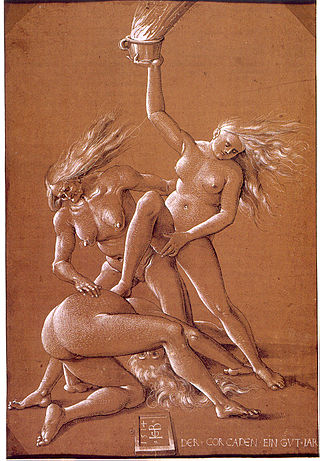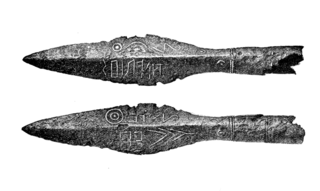
Freyr, sometimes anglicized as Frey, is a widely attested god in Norse mythology, associated with kingship, fertility, peace, prosperity, fair weather, and good harvest. Freyr, sometimes referred to as Yngvi-Freyr, was especially associated with Sweden and seen as an ancestor of the Swedish royal house. According to Adam of Bremen, Freyr was associated with peace and pleasure, and was represented with a phallic statue in the Temple at Uppsala. According to Snorri Sturluson, Freyr was "the most renowned of the æsir", and was venerated for good harvest and peace.

Satanism refers to a group of religious, ideological and/or philosophical beliefs based on Satan – particularly the worship or veneration of him. Satan is a figure of the devil in Christian belief, a fallen angel and leader of the devils who tempts humans into sin. For many centuries the term was used by various Christian groups as an accusation against ideological opponents. Actually self-identified Satanism is recent, and is thought to have begun with the founding of the Church of Satan by Anton LaVey in the United States in 1966 – that "church" being an atheistic group that does not believe in a literal Satan. Sharing "historical connections and family resemblances" with Satanism, and sometimes overlapping with it, are paganism, ceremonial magic, and "other dark entities such as Set, Lilith, Hecate, and Chaos", from the occult and the 'Left Hand Path milieu.'

Theistic Satanism, otherwise referred to as religious Satanism, spiritual Satanism, or traditional Satanism, is an umbrella term for religious groups that consider Satan, the Devil, to objectively exist as a deity, supernatural entity, or spiritual being worthy of worship or reverence, whom individuals may contact and convene with, in contrast to the atheistic archetype, metaphor, or symbol found in LaVeyan Satanism. Organizations who uphold theistic Satanist beliefs most often have few adherents, are loosely affiliated or constitute themselves as independent groups and cabals, which have largely self-marginalized. Another prominent characteristic of theistic Satanism is the use of various types of magic. Most theistic Satanist groups exist in relatively new models and ideologies, many of which are independent of the Abrahamic religions.

European witchcraft is a multifaceted historical and cultural phenomenon that unfolded over centuries, leaving a mark on the continent's social, religious, and legal landscapes. The roots of European witchcraft trace back to classical antiquity when concepts of magic and religion were closely related, and society closely integrated magic and supernatural beliefs. Ancient Rome, then a pagan society, had laws against harmful magic. In the Middle Ages, accusations of heresy and devil worship grew more prevalent. By the early modern period, major witch hunts began to take place, partly fueled by religious tensions, societal anxieties, and economic upheaval. Witches were often viewed as dangerous sorceresses or sorcerers in a pact with the Devil, capable of causing harm through black magic. A feminist interpretation of the witch trials is that misogynist views of women led to the association of women and malevolent witchcraft.
Malin Matsdotter or Mattsdotter, also known as Rumpare-Malin was an alleged Swedish witch. She is known as one of few people in Sweden confirmed to have been executed by burning for witchcraft, and the only one to be executed by this method during the famous witch hunt Det Stora oväsendet in Sweden during 1668–1676, which ended with her execution.

Werewolf witch trials were witch trials combined with werewolf trials. Belief in werewolves developed parallel to the belief in European witches, in the course of the Late Middle Ages and the Early Modern period. Like the witchcraft trials as a whole, the trial of supposed werewolves emerged in what is now Switzerland during the Valais witch trials in the early 15th century and spread throughout Europe in the 16th, peaking in the 17th and subsiding by the 18th century. The persecution of werewolves and the associated folklore is an integral part of the "witch-hunt" phenomenon, albeit a marginal one, accusations of lycanthropy involved in only a small fraction of witchcraft trials.
Märet Jonsdotter was an alleged Swedish witch. She is one of the most known victims of the persecutions of sorcery in her country; she was the first person accused of this in the great witch hysteria called det stora oväsendet of 1668–1676, and her trial unleashed the beginning of the real witch hunt in Sweden, which was to cause the death of around 280 people in those eight years. She was known by the name "Big Märet" because she had a younger sister with the same name called "Small Märet" Jonsdotter.
Lars Nilsson was a Sami who was burned at the stake for being a follower of the old Sami religion in Arjeplog in Sweden during the time of the Christianization of the Sámi people.
Anna Eriksdotter or Anna Ersdotter called Sotpackan, was a Swedish woman who was executed for witchcraft. She was the last person to be executed for witchcraft in Sweden.
Ragnhild Tregagås or Tregagás was a Norwegian woman from Bergen. From 1324 to 1325, Tregagås was accused and convicted of exercising witchcraft and selling her soul to the devil. She was "accused of performing magical rituals of a harmful nature, demonism and heresy" as well as the crimes of adultery and incest with her cousin, Bård. She was sentenced to strict fasting and a seven-year-long pilgrimage to holy places outside of Norway by Bishopp Audfinn Sigurdsson, as documented in his proclamation "De quaddam lapsa in heresim Ragnhild Tregagås" and the sentencing "Alia in eodem crimine". It is likely that Ragnhild Tregagås held a higher social position in Bergen, as the Bishop dealt with her personally and did not sentence her to death. There is little documentation on who Ragnhild Tregagås was as a person. Due to the date of her trial, it is likely that she was born in the late 13th century. There is also no recorded death date for Ragnhild Tregagås. She was married, her husband's name is undocumented, and he died before the trial, likely unaware of his wife's adultery. The trial against Ragnhild Tregagås is the only one concerning witchcraft that is known from medieval Norway, taking place 250 years before the witch-hunt in Norway started.
Gertrud Svensdotter (1656–1675) was a Swedish shepherdess. She was the witness and accuser in the witch trial against Märet Jonsdotter in 1668, the trial that unleashed the great witch hysteria in Sweden called Stora oväsendet, involving a series of witch trials in many parts of the nation and lasting until 1676.

Gothic paganism was the original religion of the Goths before their conversion to Christianity.
Ragvald Odenskarl or Ragnvald Odiakarl, was a Swede who was executed for being a declared follower of the Norse religion. His case is significant. It was very uncommon to openly declare oneself a "Pagan" during this period, and his testimony indicate that the old Pagan Norse religion were still practiced by some in Sweden as late as the 15th-century.

Sweden was a country with few witch trials compared to other countries in Europe. In Sweden, about four hundred people were executed for witchcraft prior to the last case in 1704. Most of these cases occurred during a short but intense period; the eight years between 1668 and 1676, when the witch hysteria called Det stora oväsendet took place, causing a large number of witch trials in the country. It is this infamous period of intensive witch hunt that is most well known and explored.

The Witch trials in Denmark are poorly documented, with the exception of the region of Jylland in the 1609–1687 period. The most intense period in the Danish witchcraft persecutions was the great witch hunt of 1617–1625, when most executions took place, which was affected by a new witchcraft act introduced in 1617.

The Witch trials in Iceland were conducted by the Danish authorities, who introduced the belief in witchcraft as well as the Danish Witchcraft Act in the 17th century, and then stopped the persecutions. Similar to the case of Witch trials in Latvia and Estonia, the witch trials were introduced by a foreign elite power in an area with weak Christianity, in order to ensure religious conformity. Iceland was uncommon for Europe in that magic as such was viewed favorably on the island, and the majority of those executed were men, which it had in common with only the witch trials in Finland.
Witch trials in Latvia and Estonia were mainly conducted by the Baltic German elite of clergy, nobility and burghers against the indigenous peasantry in order to persecute Paganism by use of Christian demonology and witchcraft ideology. In this aspect, they are similar to the Witch trials in Iceland. They are badly documented, as many would have been conducted by the private estate courts of the landlords, which did not preserve any court protocols.
The witch trials in Orthodox Russia were different in character than the witch trials in Roman Catholic and Protestant Europe due to the differing cultural and religious background. It is often treated as an exception to modern theories of witch-hunts, due to the perceived difference in scale, the gender distribution of those accused, and the lack of focus on the demonology of a witch who made a pact with Satan and attended a Witches' Sabbath, but only on the practice of magic as such.

The Katarina witch trials took place in the Katarina Parish in the capital of Stockholm in Sweden in 1676. It was a part of the big witch hunt known as the Great noise, which took place in Sweden between the years 1668 and 1676, and it also illustrated the end of it.
Elsa Thomasdotter, known as "Lilla Guden", was a Swedish cunning woman or folk healer. She was one of the people accused of witchcraft in the Katarina witch trials during the witch hunt known as the Great noise, which took place in Sweden in 1668–1676.








